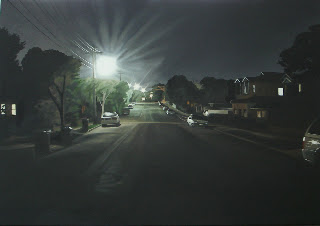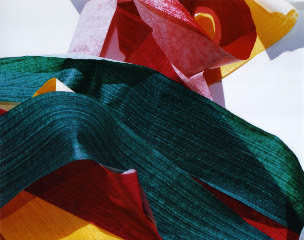The recent exhibition of new work by Halinka Orszulok and Rachel Scott at MOP was shit hot. While not curated as a joint show, these concurrent exhibitions both utilised suburbia as a literal and metaphorical site for investigating what is common to individual subjective experience.
To my mind, Orszulok has produced her best group of works in this series Melrose Park, seven paintings depicting scenes from the suburb she grew up in. Her remarkable competence with traditional representational technique allows her to produce photo realistic paintings which evoke intense sense memories, not just of her experience, but of our own.

Halinka Orszulok, Melrose Park, 2007.
Orszulok’s suburbia is both personal and generic then. The homes, the streets, and the park lands that surround them are purposefully undistinguished, reminding us of the way in which our relationship to the spaces we inhabit is always, already mediated by our experiences of them. It is representative of a space in which conventional dichotomies break down and are in a constant state of renegotiation: private versus public, safety versus danger, home versus displacement. And perhaps the creepiest of all: fantasy versus reality.
Orszulok’s depiction of these spaces at night, concealed and revealed through the play of light and dark, is not accidental in relation to her preoccupation with the uncanny. The scenes she paints are of places filled with anxious anticipation. For example, a picture of a girl’s toilet block draws our attention to the ambiguity of its signification. This is just a fancy way of saying that one person’s nostalgia for smoking menthol cigarettes is another’s fear of a random act of violence.
Look inside one of Oszulok’s bedroom windows and you may just find someone like Rachel Scott making art.

Scott’s (Don’t) Beat Yourself Up Over It featured framed, original poems written by her as a teenager in the late 80s and a video depicting a long session of self-flagellation with rose stems in her suburban bedroom, set to a Robbie Williams smash hit.
In this exhibition Scott puts her money where her mouth is in relation to her general project of articulating an aesthetics of the psychology of ‘failure, longing, human weakness and self-consciousness’. The poems are cringe worthy, adolescent attempts at profundity – ‘A nothing, a nobody/But somebody deep inside’ – the video as dramatic as the inane arguments over the car keys one imagines have been taking place for years in the generic lounge room beyond: I Just Want To Feel Real Love, just like you Robbie, just like all of us.
Scott’s work, both as an act of art and life, pricks the pretension of Nietzsche’s beautiful idea that pain does not necessarily make one a better human being but certainly a more profound one. Maybe that’s OK for the Germans, she seems to be saying, but some of us grew up in Crows Nest.
This is not to undermine the seriousness of Scott as an artist. She deals with some big ideas, with modesty and humour. For instance, these latest works give lie to received ideas about art as a mode of self-expression: it is not simply the externalization of the creative individual’s innate psychological states and feelings but rather a performative act constitutive of the subject-as-artist (or poet, or love interest, etc). By exposing the amateur aspects of the performance of her own psychodrama she allows us to see, in a more general way, how our often pretentious aspirations to overcome the chronic mediocrity of day-to-day existence congeal, over time, into something perhaps equally mundane. Existential alienation as a lifestyle concept.
Carrie Miller
